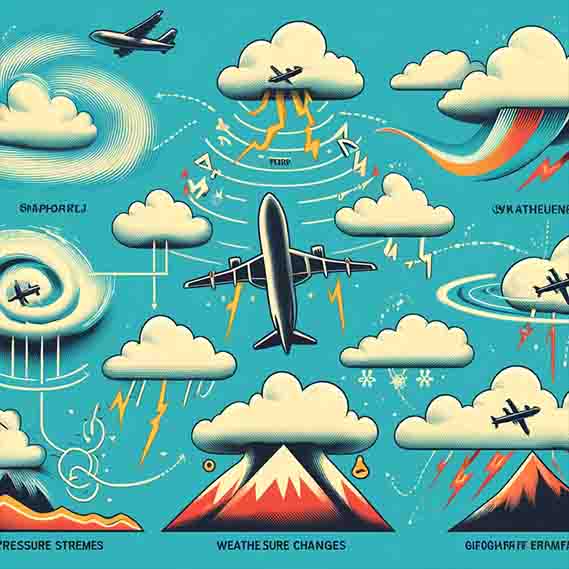Table of Contents
You need to give a few minutes to understand What Is Turbulence on a Plane? While turbulence is a widely common phenomenon that brings anxiety and discomfort to flyers, knowing what it is, the situations that cause it, and the response of the aircraft help in allaying fear. It will be true with the article explaining what turbulence is, its types, causes, and the precautionary features taken for passenger safety.
Understanding Turbulence
Turbulence is the irregular chaotic motion of the air. As a result, in the process of moving, the aircraft feels somewhat bumpy. It is caused by several factors that break up and disturb the smooth flow of air around its wings, altering its altitude and direction. In most cases, it would be light, though sometimes it might be heavy; usually, it is not dangerous for the airplane itself because of modern engineering and design.

Forms of Turbulence – What Is Turbulence on a Plane?
Turbulences of an aircraft can be classified into different types according to their characteristics and causes:

- Clear Air Turbulence (CAT):
- Cause: Clear Air Turbulence occurs at high levels, normally above 20,000 feet, and has no relation to the clouds and weather systems. CAT is caused by the interaction of the different air masses moving at different speeds.
- Characteristics: CAT is often erratic and can happen at unexpected times. Many times, it does not provide enough time for detection and avoidance by the pilots.
- Mechanical Turbulence:
- Cause: Mechanical turbulence is caused by physical obstructions like mountains, buildings, and other structures which block and cause disruptions in the flow of air.
- Characteristics: It is more common at lower altitudes, especially during take-off and landing, generally being localized around the obstruction.
- Thermal Turbulence:
- Cause: This unequal heating of the Earth’s surface causes rising columns of warm air called thermals.
- Properties: This type of turbulence usually occurs in the daytime over warm sunny days at all altitudes.
- Wake Turbulence:
- Cause: When the airplane is cutting through the air wake turbulence is created. It creates vortices at the wing tip.
- Characteristics: This impacts the following aircraft, especially during the takeoff and landing. Proper training is given to the pilots to maintain safe distances and avoid wake turbulence.
- Frontal Turbulence:
- Cause: Frontal Turbulence results from the collision of two air masses of different temperatures along a weather front.
- Features: Companied change in weather. The intensity depends on the temperature difference between the air masses.
How Did The World’s First Airplane Look At The Time Of Their Invention?
Sources of Turbulence
Other factors of the atmosphere and environment are turbulence creators.
- Jet Streams:
- Jet streams are easterly high-altitude wind belts within the upper atmosphere. Crossing these winds, an airplane experiences a great deal of turbulence.
- Weather Systems:
- The injection of the air masses’ mixing and their resultant instability can develop in a tempestuous way: storms, cold and warm fronts, and other phenomena of needful weather.
- Air Pressure Changes:
- Fluctuations in air pressure may lead to instability in the air current.
- Geographical Features:
- Mountains, valleys, and other forms of relief landforms may change the flow of air and give rise to turbulence around them.

Effects of Turbulence on Aircraft
Turbulence differs in impact on an aircraft and its passengers.
- Passenger Discomfort:
- Turbulence can cause discomfort, anxiety, and even motion sickness in extreme cases. It is felt as bumps, jolts, and sudden drops.
- Flight Operations:
- Pilots have to adjust the flight path while ascending or descending in altitude and speed to pass through or around the roughest patches of air. This normally leads to longer flight times and more fuel consumption.
- Aircraft Strain:
- While it is true that modern aircraft are designed to withstand the forces created by turbulence, it still stresses the structure and loads on the airframe and aircraft components. This in turn would mean that, given the fact that the aircraft is maintained and inspected regularly, it is safe and airworthy.

Operations Safety and Crew Training
Here are applied such precautionary methods and procedures as reducing the effects of turbulence:
- Advanced Weather Forecasting:
- Technology helps apply the kinds of forecasting meteorologists with advanced technologies in trying to predict areas of turbulence to have pilots with the opportunity to plan their routes away from the worst condition areas.
- Pilot Training:
- They are well trained in the best ways of dealing with turbulence and how to control everything in case the turbulence occurs for them to stay in control and passengers to be kept safe. Communication between cruise pilots and passengers has to be tactful in cases of turbulence.
- Aircraft Design:
- Modern aircraft have been designed to cater to this kind of turbulence through the flexible wing and rigidity in structure, which can absorb and dissipate the forces being created by turbulent air.
- Seatbelt Usage:
- Passengers are advised to fasten seat belts while seated even when the seat belt sign is off to avoid injury in case of unexpected turbulence.

Myths and Facts of Turbulence
Here are some of the myths about this problem, which incept an enormous amount of fear in the minds of the passengers:
- Myth: The Plane Goes Down Because of Turbulence:
- Fact: Scarcely ever is a cause of crashes by turbulence. The aircraft are built in such a way that they can fly within the worst imaginable turbulence, whereas their pilots learn the professional techniques allowing to get out of even the most severe turbulence safely.
- Myth: Pilots Can Always Avoid Turbulence:
- Fact: Even though most of the turbulence-prone areas have been well documented, one can still avoid most of the turbulence. A few types, such as Clear Air Turbulence cannot be forecast or are found out by the pilots using tools.
- Myth: Turbulence is the Precursor to Bad Weather:
- Fact: Turbulence may be experienced on a flight even with clear skies and favorable weather over the ground, precisely while at higher levels, when jet streams and atmospheric conditions come into play.

So, What Is Turbulence on a Plane?
Turbulence should be considered a natural phenomenon in an air system. Understanding the causes and types of safety measures in place would help to allay passengers’ fears. Modern aircraft are pitched to carry any form of turbulence, and pilots are trained to ensure their safety and comfort. Even though it feels nasty, turbulence is not serious, and it can be managed under proper care.
Also read: Why Leap Year Comes in February



